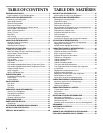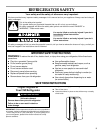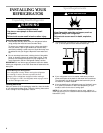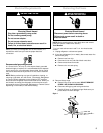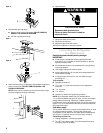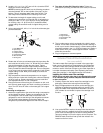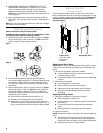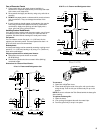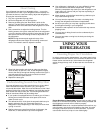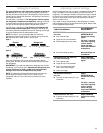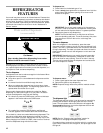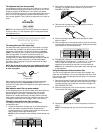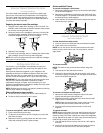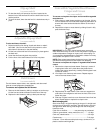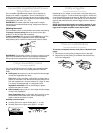
6
Style 2
4. Disassemble right top hinge.
■ Remove hinge cover and screws. DO NOT REMOVE
SCREW 1 AS SHOWN IN DIAGRAM.
■ Lift door up off bottom hinge.
Style 1
Style 2
5. Remove bottom hinge, if necessary. Both bottom hinges have
similar construction. DO NOT REMOVE SCREW 1 AS
SHOWN IN DIAGRAM.
NOTE: It may not be necessary to remove the bottom hinge
to move refrigerator through a doorway.
6. Replace doors.
7. Reconnect both ground wires.
8. Reconnect wiring plug.
9. Replace hinge cover and screws.
10. Plug in refrigerator or reconnect power.
Connecting the Refrigerator
to a Water Source
Read all directions carefully before you begin.
IMPORTANT:
■ If operating the refrigerator before installing the water
connection, turn ice maker to the OFF position to prevent
operation without water.
■ All installations must be in accordance with local plumbing
code requirements.
■ Use copper tubing and check for leaks.
■ Install copper tubing only in areas where temperatures will
remain above freezing.
■ It may take up to 24 hours for your ice maker to begin
producing ice.
Tools required:
■ Standard screwdriver
■ ⁷⁄₁₆ in. and ¹⁄₂ in. open-end wrenches or two adjustable
wrenches
■ ¹⁄₄ in. nut driver
■ ¹⁄₄ in. drill bit
■ Hand drill or electric drill (properly grounded)
NOTE: Your refrigerator dealer has a kit available with a
¹⁄₄ in. (6.35 mm) saddle-type shut-off valve, a union, and copper
tubing. Before purchasing, make sure a saddle-type valve
complies with your local plumbing codes. Do not use a piercing-
type or ³⁄₁₆ in. (4.76 mm) saddle valve which reduces water flow
and clogs more easily.
Cold water supply
The ice maker water valve contains a flow washer which is used
as a water pressure regulator. The ice maker needs to be
connected to a cold water line with water pressure between 30
and 120 psi. If a problem occurs, call your utility company.
Connecting to water line:
1. Unplug refrigerator or disconnect power.
2. Turn OFF main water supply. Turn ON nearest faucet long
enough to clear line of water.
1
WARNING
Electrical Shock Hazard
Reconnect both ground wires.
Failure to do so can result in death or
electrical shock.




